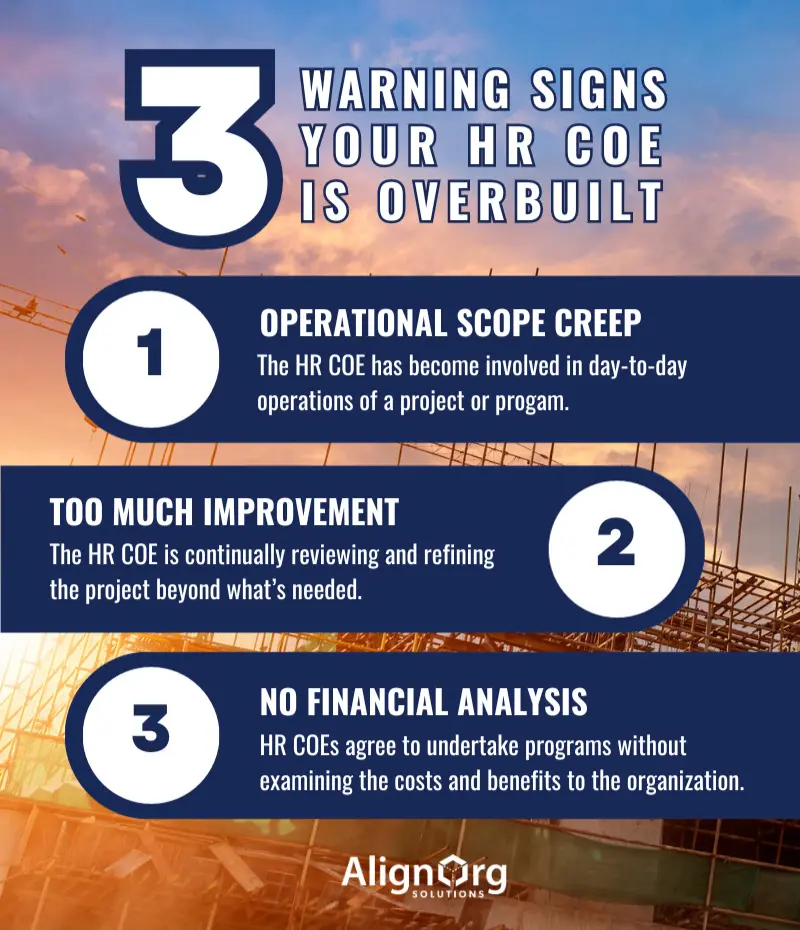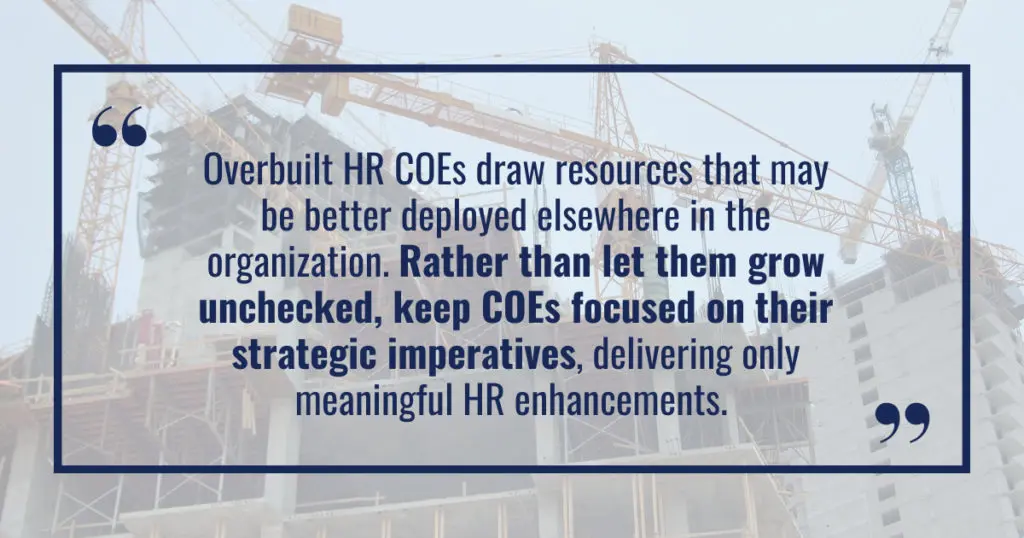If you’ve ever built a house, you understand the number of specialists required to get the job done. You’ll have plumbers, drywallers, maybe even someone to install a security system or put up the blinds. After you move in, however, the workers disperse. You may have to call for help on occasion, but you certainly don’t need the entire crew hanging around.
The same can be said for HR COEs, or human resource centers of expertise. A COE is a group of employees with specialized skills, gathered together to help develop policies and programs. In the HR world, these often include initiatives like executive recruitment and employee rewards. As with building a house, organizations initially need robust COEs to create these programs from the ground up. Once the programs are up and running, the focus should shift from new work to periodic maintenance. All too often, however, that’s not what happens. In reality, the needs are scaled back, but the HR COEs stay the same size. Let’s examine the issues that come with these overbuilt COEs, and explore ways leaders can avoid them.

Problem #1: Operational Scope Creep
Although COEs are usually only developed to create new programs and update existing processes, they often get drawn into day-to-day operations. After all, they know why the programs were created in the first place and how they were designed to function.
This means, however, that as the number of programs and processes grow, the COEs’ operational and administrative burdens grow as well. Eventually, the team expands far beyond their original intent. To prevent this, HR leaders need to determine where to draw the line between development and maintenance. It’s critical to know when a project or process should be handed off from COE to the HR business partner.
Problem #2: Too Much Improvement
Just as you don’t need a stream of subcontractors milling around your house after it’s built, most HR policies and programs don’t require constant work from COEs. To avoid the problem of “too much improvement,” the manager who leads the COE should look at all the programs within their domain and decide how often they should be reviewed. When that review does occur, leaders’ HR specialists should connect with stakeholders to confirm that all needs are being met. COEs should not assume that just because they created the program, they understand all ongoing requirements. Finally, COE managers should avoid overbuilding. Remember the key design principle, “fit for purpose,” and be okay with developing only what is needed.
Problem #3: A Dollar Spent in HR is a Dollar Not Spent Somewhere Else
A third problem with overbuilt COEs is the tendency not to consider the cost burden to the organization when making decisions. When a business unit makes a request, a COE often responds quickly in an attempt to be responsive to the business’ needs. More projects are added to the slate without considering the impact to the broader organization. Instead, each HR program, process or policy should undergo financial analysis to fully understand the costs and benefits and only be undertaken if it truly benefits the organization as whole.
Solutions to Overbuilt HR COEs
We’ve discussed three problems that can occur when HR COEs become oversized. Let’s talk about some ways to rightsize COEs and avoid the challenges we’ve mentioned here.
Scheduling: Save resources by creating COEs that are only scheduled to conduct periodic reviews of existing programs, policies and processes. If additional work on a program is needed outside what has been scheduled, the department that requested the change should provide the budget to accomplish it.
Practical Feedback & Cost Discipline: In our experience, COEs will often “find” enough work to keep busy. Instead, COE leaders should make a practice of asking their internal clients what projects they want to invest in. Ask leaders, “If we were to work on or develop X, would that be something you care enough about to pay for?” The answer will often be, “Probably not. It looks good on paper, but I don’t know if our department or business unit would finance that process or program.” This practical feedback helps contain COEs excited to tackle the next big thing.
Conclusion: What Does Your Organization Truly Need From an HR COE?

Overbuilt HR COEs draw resources and expertise that may be better deployed elsewhere in the organization. Rather than let them grow unchecked, keep COEs focused on their strategic imperatives, only delivering HR enhancements that are meaningful. This will ensure that the COEs do not expand beyond what the organization truly needs.
If you’ve found these tips helpful, check out our newest Executive Guide, Maximizing the HR Operating Model, where we explore how to create an HR department that helps your agency adapt to challenges and prepare for future growth.
